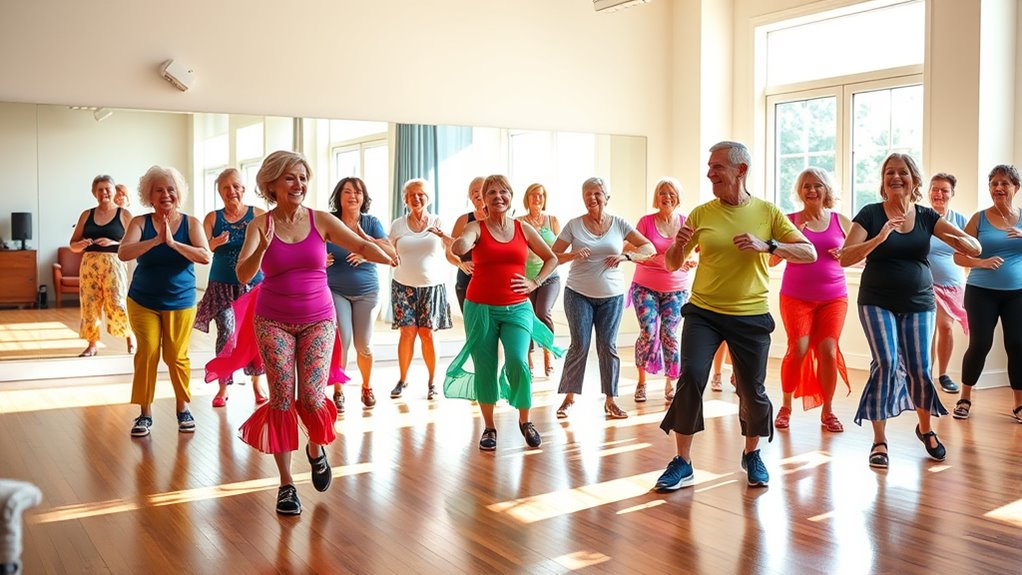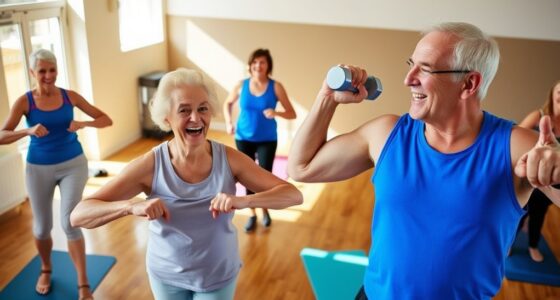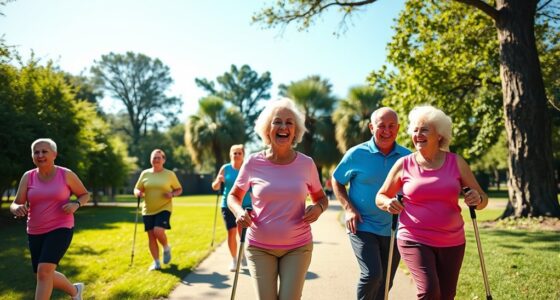Zumba is a fun and engaging way for you to boost your fitness and groove your way to a healthier you! It’s designed for seniors, combining dance movements with upbeat music to improve cardiovascular health, balance, and coordination. You’ll find that simple warm-up techniques and enjoyable choreography suit your fitness level and promote social interaction. Plus, it builds strength and enhances your overall well-being. Stick around to discover even more ways Zumba can benefit your health!
Key Takeaways
- Zumba enhances cardiovascular health, promoting better heart efficiency and lowering blood pressure for seniors.
- The engaging rhythm and movements improve coordination and balance, essential for fall prevention.
- Participating in Zumba fosters social interaction, reducing feelings of loneliness and enhancing mental well-being.
- Simple warm-up and cool-down techniques help prevent injuries and promote overall flexibility.
- Adaptable choreography allows seniors to enjoy varying intensity levels, making fitness accessible and fun.
Benefits of Zumba for Seniors
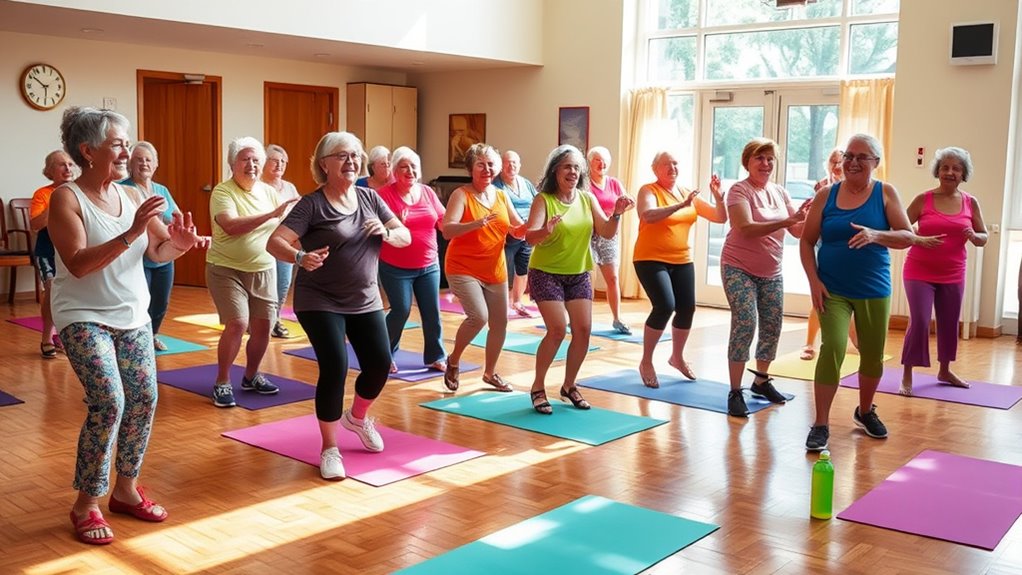
Zumba offers seniors a fun and dynamic way to stay active while reaping numerous health benefits. By participating regularly, you can improve your cardiovascular health, as studies show it enhances heart efficiency and lowers blood pressure. Additionally, engaging in regular physical activity can promote quality sleep, which is vital for overall health and well-being. Regular exercise is also linked to improved respiratory health, as it helps maintain lung function and overall fitness. Including a balanced diet rich in whole foods can further enhance your energy levels and overall fitness.
The dance movements also boost your coordination and balance, which are essential for fall prevention. Plus, Zumba classes provide a social atmosphere, reducing feelings of loneliness and depression as you connect with peers. Engaging in social activities can also enhance emotional regulation, promoting better mental health.
With its low-impact nature, Zumba allows you to enjoy a great workout while minimizing injury risks, making it suitable for different fitness levels. Engaging in Zumba can help with weight management, increase your energy levels, and ultimately enhance your overall quality of life. Additionally, incorporating stress management techniques through enjoyable activities like Zumba can further improve mental health and overall well-being.
Basic Movements to Get Started

To kick off your Zumba workout, start with simple warm-up techniques like side steps and arm circles to get your body ready. Incorporating movements like toe taps and heel taps helps gently stretch your muscles for the session ahead. As you progress, adding arm movements can boost your coordination and keep you engaged throughout the workout. Additionally, staying hydrated with juices like beet juice can enhance your energy levels and overall performance during your fitness routine. Drinking fresh juices made from fruits like mango and pineapple can provide extra nutrients to support your exercise efforts. Consider incorporating essential oils to promote relaxation and enhance your overall well-being during your workouts. To further support your hydration, consider celery juice as it is known for its hydration and electrolyte balance support. Maintaining a balanced diet, including essential fatty acids, can also contribute to your overall fitness and health during your exercise routine.
Warm-Up Techniques Explained
Starting your Zumba workout with effective warm-up techniques is essential for preparing your body and preventing injury.
Begin with a simple side-to-side step to gradually increase your heart rate. Next, incorporate arm circles to engage your shoulder muscles and improve upper body mobility. Additionally, warming up can enhance cognitive function by increasing blood flow to the brain. Moreover, engaging in physical activity like Zumba can help combat respiratory issues linked to air pollution, promoting overall health.
Practice toe taps to the front and side to gently stretch and activate your leg muscles, setting the stage for a full workout. Don’t forget to include heel taps to stretch the back of your legs, promoting flexibility and preventing injury during more intense movements. Additionally, remember that the importance of relaxation before exercise can greatly enhance your overall performance. Maintaining proper hydration is also crucial to support your workout routine.
Finally, utilize variations of arm movements alongside these basic steps to enhance your overall engagement and coordination while warming up. This will help you feel ready and energized for your Zumba session! Additionally, ensuring a proper warm-up helps to prevent injury by gradually increasing blood flow and flexibility in your muscles.
Simple Movements Overview
After warming up, you’re ready to explore some simple movements that form the foundation of your Zumba workout. These basic steps include side-to-side movements, arm circles, toe taps, and heel taps. They’re easy to follow, making it simple to adapt them to your fitness level, even with chair options available. Integrating arm movements with basic steps enhances your engagement, promoting full-body activation. Practicing these movements can help in developing a growth mindset, which is essential for building resilience as you progress in your fitness journey. Additionally, engaging in physical activity can reduce anxiety and improve overall well-being. Establishing consistent routines in your workouts can further enhance your commitment to fitness. Moreover, staying active can boost your overall life satisfaction, leading to a more fulfilling experience. As you engage in these movements, remember that maintaining a bullish outlook on your progress can significantly motivate your fitness journey.
Here’s a quick overview of the movements:
| Movement | Purpose | Variation |
|---|---|---|
| Side-to-Side | Coordination | Add arm movements |
| Arm Circles | Full-body engagement | Increase circle size |
| Toe Taps | Balance improvement | Perform seated |
| Heel Taps | Strength building | Add a twist with arms |
| Simple Steps | Enjoyment and fun | Change direction |
These movements foster a supportive community spirit while you get fit!
Engaging Cardio and Coordination Exercises

As you immerse yourself in Zumba workouts, you’ll find that engaging in cardio exercises not only boosts your heart health but also enhances your coordination and balance. Incorporating smart home tips can help you create a more comfortable environment for your workouts. Additionally, using best lifestyle products can further enhance your Zumba experience by providing convenient tools for hydration and recovery.
Moves like grapevine steps and knee lifts are excellent for maintaining mobility as you age. By incorporating arm movements alongside lower body exercises—think bicep curls with toe taps—you can achieve a full-body workout that strengthens both body and coordination. Practicing positive thinking strategies can further motivate you to stay committed to your fitness journey.
The simple choreography allows you to vary the intensity, making it adaptable for your fitness level. Plus, activities focusing on forward and backward motions help reinforce essential coordination skills for daily tasks.
Regular participation in these engaging routines also fosters a sense of community, reducing feelings of isolation while promoting overall mental well-being. Additionally, emotional and psychological growth is enhanced through the social interactions experienced in group classes.
Strengthening Through Dance
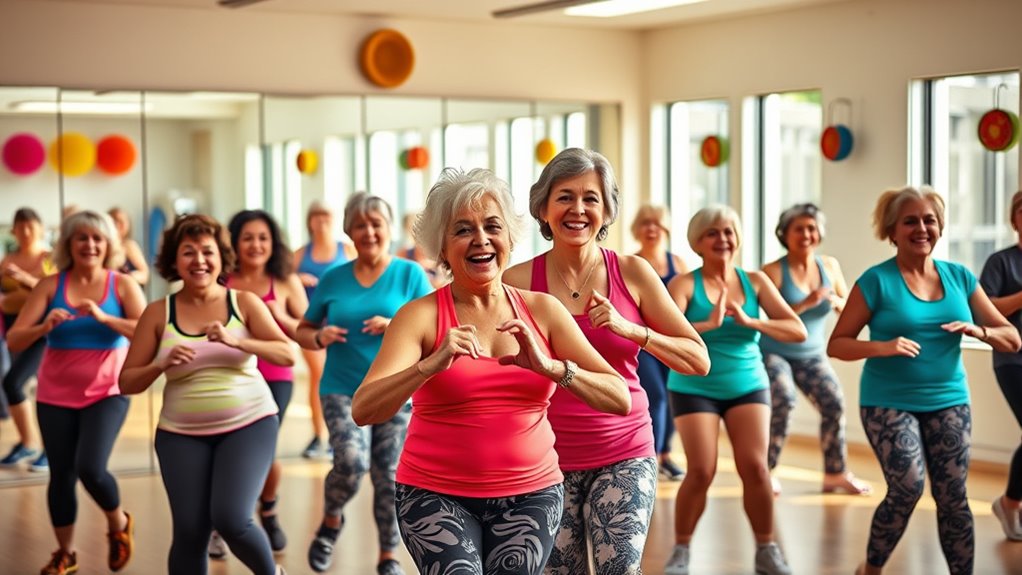
When you participate in Zumba, you’re not just having fun; you’re also building strength, balance, and coordination.
The dance moves engage your core and arms, which helps improve your overall body strength.
Plus, the adaptable nature of Zumba means everyone can enjoy these benefits, regardless of their fitness level.
Dance for Strength
While you might think of Zumba primarily as a fun dance workout, it also offers significant strength-building benefits.
Through dynamic choreography that incorporates various arm and leg movements, you can effectively enhance your muscle strength and coordination.
Here’s how Zumba helps you get stronger:
- Strength-building exercises: Many routines include movements like bicep curls and knee lifts.
- Increased flexibility: Regular participation improves your range of motion.
- Enhanced stability: Dance-based exercises can reduce the risk of falls.
- Social engagement: Group classes foster community, boosting your mental health.
Balance and Coordination
Building on the strength gained through dance, Zumba also plays an essential role in enhancing balance and coordination. The dance-based movements require you to shift your weight and move in different directions, engaging stabilizing muscles vital for balance.
Incorporating grapevine steps and knee lifts in routines challenges your body to perform simultaneous arm and leg movements, improving coordination. The rhythmic nature of Zumba helps develop motor skills and spatial awareness, allowing you to navigate your movements in sync with the music.
Regularly participating in Zumba classes can greatly reduce the risk of falls over time, especially for seniors. Plus, the cognitive demands of remembering sequences and patterns while moving further enhance your overall coordination skills.
Stretching and Cool Down Techniques

To guarantee a smooth shift from the energetic movements of Zumba, incorporating effective stretching and cool down techniques is essential.
These practices help enhance flexibility and relieve muscle tension after your workout. Here are some techniques you can include:
- Warrior pose and side body bends to improve flexibility.
- Gentle movements like repeated kicks and side-to-side motions to gradually lower your heart rate.
- Bicep curls and toe taps to ease tension and engage various muscle groups.
- Focus on breathing and gentle movements, ensuring you feel a good stretch without pain.
Adjusting the intensity—like tilting back or modifying positions—allows you to personalize your cool down experience, making it comfortable and effective for your fitness level.
Ensuring Safety and Adaptability

Ensuring safety and adaptability in Zumba workouts for seniors is essential for fostering a positive and enjoyable experience. The program allows you to modify movements, whether you’re in a chair or need to lower the intensity. Each class includes warm-ups and cool-downs to prepare your body and safely reduce your heart rate, minimizing injury risk.
Here’s a quick reference table to keep in mind:
| Safety Tips | Adaptability Options | Reminder |
|---|---|---|
| Maintain a straight back | Perform seated moves | Listen to your body |
| Use wider foot positions | Adjust intensity | Prioritize gentle stretches |
| Focus on controlled movements | Explore all options | Stay hydrated |
Join the Community and Stay Active

Joining a community fitness program like Zumba can greatly boost your social connections while keeping you active. When you participate in group workouts, you not only get fit but also find motivation and accountability.
Here’s how joining a Zumba class can enhance your experience:
- Connect with others who share your interests.
- Enjoy workouts tailored to various fitness levels and abilities.
- Experience increased motivation through a supportive environment.
- Access flexible options like online classes, making it easier to participate.
Frequently Asked Questions
What Type of Zumba Is Best for Seniors?
When choosing the best type of Zumba for seniors, consider options like Zumba Gold, which offers low-impact moves perfect for your joints.
If you prefer water workouts, Aqua Zumba adds resistance while keeping things fun.
For those with limited mobility, Chair Zumba allows you to participate safely while seated.
If you want to build strength, Zumba Toning incorporates light weights.
Each option guarantees you stay active while enjoying the music!
How Many Days a Week Should You Do Zumba to See Results?
Imagine stepping into a vibrant dance studio, music pulsing, and energy soaring.
To see real results from Zumba, aim to join classes at least 3 to 4 days a week. This regularity helps your heart pump stronger, improves flexibility, and boosts your mood.
As you groove, you’ll not only burn calories but also enhance your coordination.
Pairing Zumba with strength training twice weekly will elevate your overall fitness and keep you feeling fantastic!
Is 30 Minutes of Zumba a Day Enough?
Yes, 30 minutes of Zumba a day is enough to see significant benefits.
You’ll boost your cardiovascular health, burn calories, and improve your coordination and balance. This moderate-intensity workout can enhance your mood and mental well-being too.
Just remember, consistency is key. If you commit to those daily sessions, you’ll notice improvements in your overall fitness and flexibility over time, making it a great addition to your routine.
Is Zumba Good for Arthritis in the Knees?
Yes, Zumba can be good for arthritis in the knees! Its low-impact movements promote flexibility and strength without putting too much strain on your joints.
You can adapt the exercises to suit your comfort level, and many classes offer modifications, including seated options.
Regular participation can improve joint function and reduce stiffness.
Just remember to consult your healthcare provider before starting to guarantee it aligns with your health needs. Enjoy moving!
Conclusion
So, lace up your sneakers and let the vibrant rhythms of Zumba sweep you off your feet! Picture yourself dancing amidst a circle of friends, laughter echoing as you groove to the beat. With every step, you’re not just moving; you’re building strength, boosting your heart, and embracing a lively community. Remember, it’s never too late to join the fun and feel the exhilaration of being active. Let the music guide you toward a fitter, more vibrant you!

